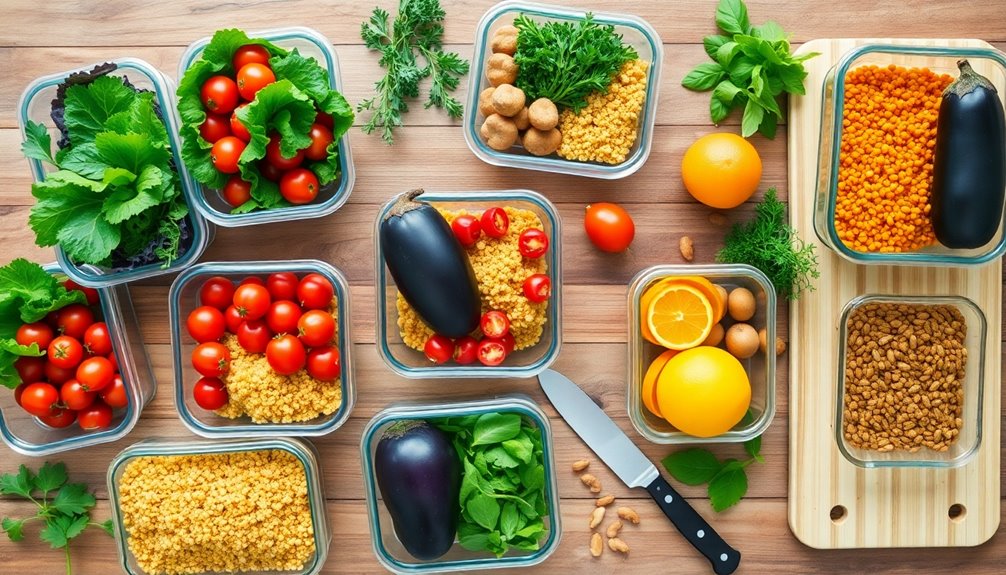To incorporate variety into your weekly meal plan, explore new ingredients and global cuisines. Try using seasonal produce from farmers' markets, and rotate your protein sources, including beans, lentils, or tofu for added nutrition. Establish theme nights to create excitement and involve your family in meal prep, making it a fun activity. Keep a recipe journal to track favorite meals and experiment with new flavors. These strategies not only enhance your meals but also improve overall health. If you're curious about more ways to spice up your meal planning, there's much more to discover.
Key Takeaways
- Explore new ingredients by visiting farmers' markets or international grocery stores to discover unique fruits, vegetables, and spices.
- Diversify protein sources weekly by incorporating alternatives like beans, tofu, lentils, and quinoa for enhanced nutrition and flavor.
- Utilize seasonal produce to create fresh, nutrient-rich meals while supporting local farmers and celebrating the changing seasons.
- Establish theme nights for meals, encouraging family involvement and excitement about trying new dishes and flavors together.
- Keep a recipe journal to track favorite meals, document new experiments, and inspire creativity in your weekly meal planning.
Explore New Ingredients
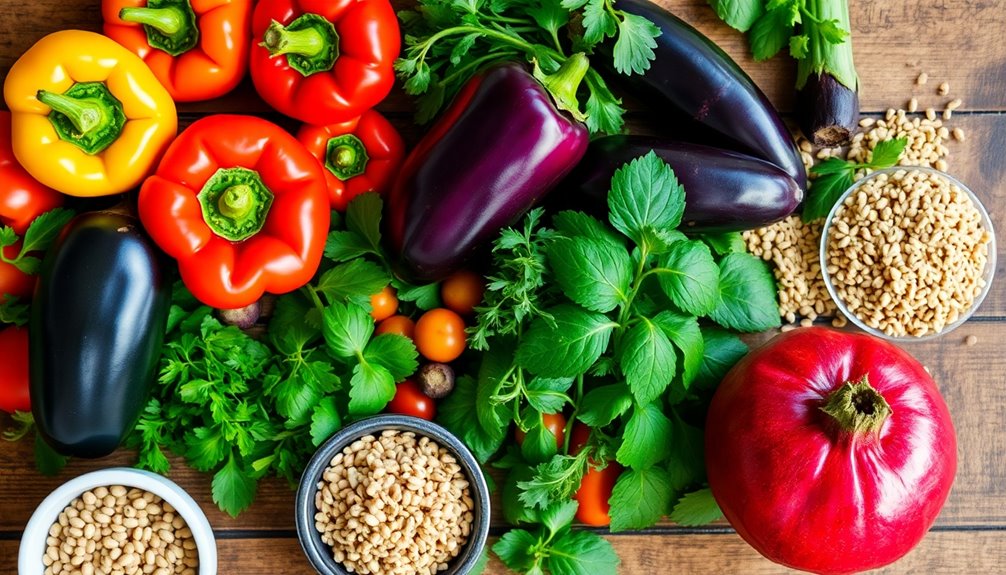
Exploring new ingredients can transform your weekly meal plan into an exciting culinary adventure. When you incorporate unfamiliar fruits, vegetables, grains, or spices, you open up a world of flavor combinations that can elevate your dishes from ordinary to extraordinary.
For instance, combining sweet roasted butternut squash with tangy feta cheese creates a delightful contrast that's both invigorating and satisfying.
Texture contrasts also play a pivotal role in making your meals more appealing. Think about adding crunchy nuts to a creamy soup or pairing soft-cooked quinoa with crisp vegetables. These elements not only enhance the eating experience but also keep your meals interesting and varied.
To get started, you might want to visit your local farmers' market or an international grocery store. You'll likely discover unique ingredients that aren't typically found in your kitchen. Experimenting with items like farro, dragon fruit, or miso can introduce you to new tastes and textures, fostering a sense of belonging in a community of food enthusiasts.
Additionally, incorporating plant-based ingredients into your meals can offer numerous health benefits such as lower cholesterol levels and enhanced heart health. Don't hesitate to look up recipes that feature these new ingredients or even create your own. Cooking with fresh, seasonal items not only supports local farmers but also enriches your diet with diverse nutrients. Remember, the goal isn't perfection but rather enjoyment and exploration. By embracing new flavors and textures, you'll find yourself excited about meal planning, and you might inspire others in your circle to join in on the culinary adventure.
Rotate Protein Sources
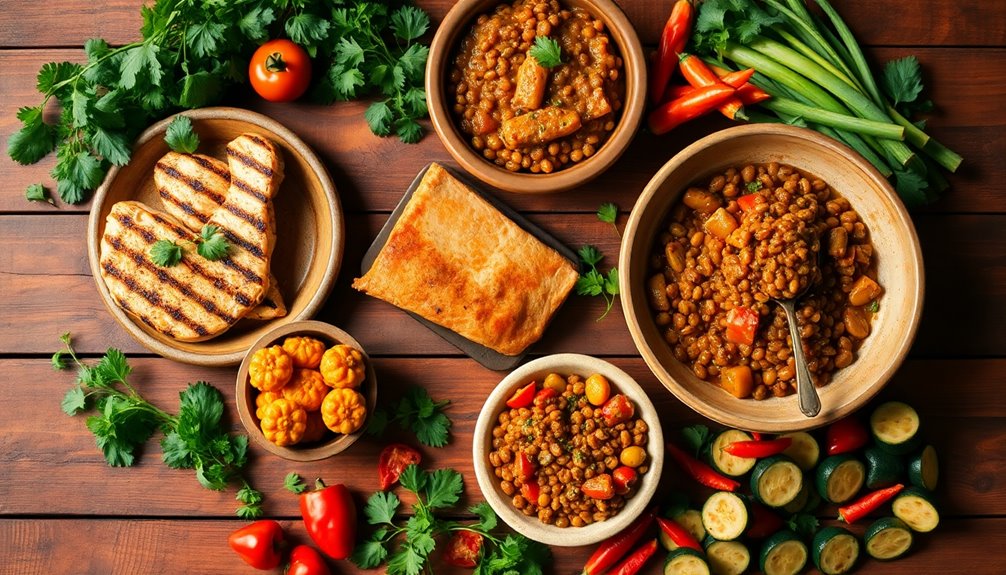
Rotating protein sources each week can greatly enhance both the nutritional value and flavor profile of your meals. By diversifying your protein choices, you not only secure a broader intake of essential nutrients but also keep your taste buds excited.
Incorporating different proteins like chicken, fish, eggs, legumes, and nuts can make a significant difference in your overall diet.
Consider flavorful alternatives to traditional meats. For instance, try incorporating lean cuts of beef or pork one week, then switch to fish or poultry the next. This rotation can help reduce the risk of developing allergies and keeps your meals interesting.
Additionally, don't overlook meatless options—these can be just as protein-packed! Beans, lentils, quinoa, and tofu offer excellent nutritional benefits while adding unique flavors and textures to your dishes. In fact, these whole-food sources of protein are healthier and can contribute to weight loss.
To make the process easier, plan your meals around a protein theme for the week. You might dedicate one week to Mediterranean flavors featuring chickpeas and fish, and the next to Asian-inspired dishes with tofu and edamame. This approach not only adds variety but also fosters a sense of belonging, as you might discover new recipes to share with friends and family.
Try Global Cuisines
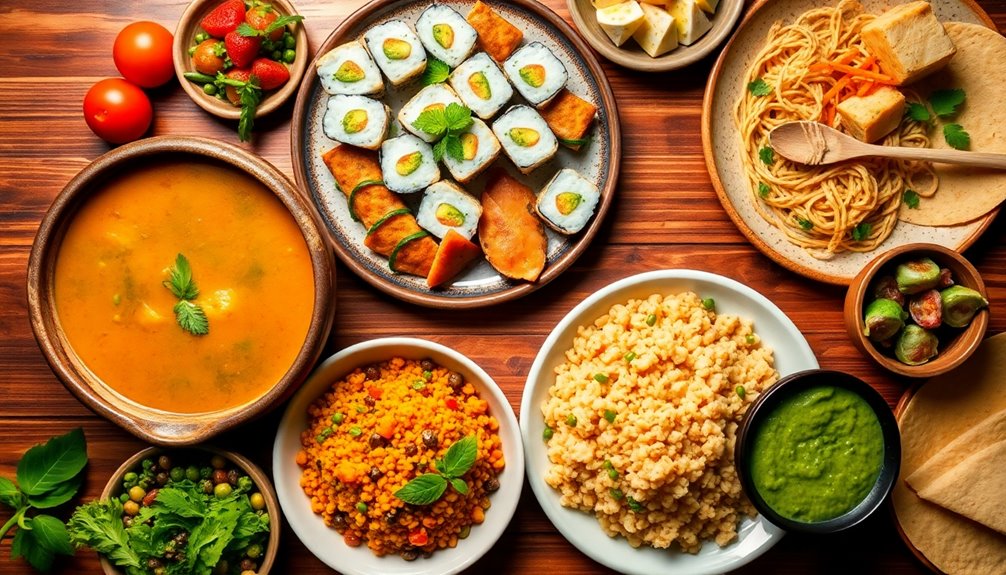
Incorporating global cuisines into your weekly meal plan can be a game-changer for your palate and nutrition. By embracing cultural exploration, you'll not only enjoy a broader range of flavors, but you'll also gain insight into different culinary traditions. Each meal becomes a taste adventure, allowing you to experience flavor fusion that can elevate the ordinary into the extraordinary.
To help you get started, consider this table featuring a variety of dishes from around the world:
| Cuisine | Dish | Key Ingredients |
|---|---|---|
| Italian | Risotto | Arborio rice, broth, Parmesan |
| Thai | Green Curry | Coconut milk, green chilies, basil |
| Mexican | Tacos | Corn tortillas, beans, avocado |
| Indian | Chana Masala | Chickpeas, tomatoes, spices |
| Japanese | Sushi | Sushi rice, nori, fish or veggies |
Each dish offers international inspiration and a unique way to incorporate diverse nutrients. By rotating these meals throughout your week, you'll not only enjoy different flavors but also enhance your cooking skills. Additionally, following a custom keto diet plan can complement your culinary adventures while supporting your health goals.
Exploring global cuisines encourages a sense of belonging, as you connect with cultures through food. Plus, it can spark conversations around the dinner table, making meals more enjoyable. So, why not set off on this culinary journey? Your taste buds will thank you, and your meals will transform into a delightful exploration of the world, right from your kitchen.
Incorporate Seasonal Produce
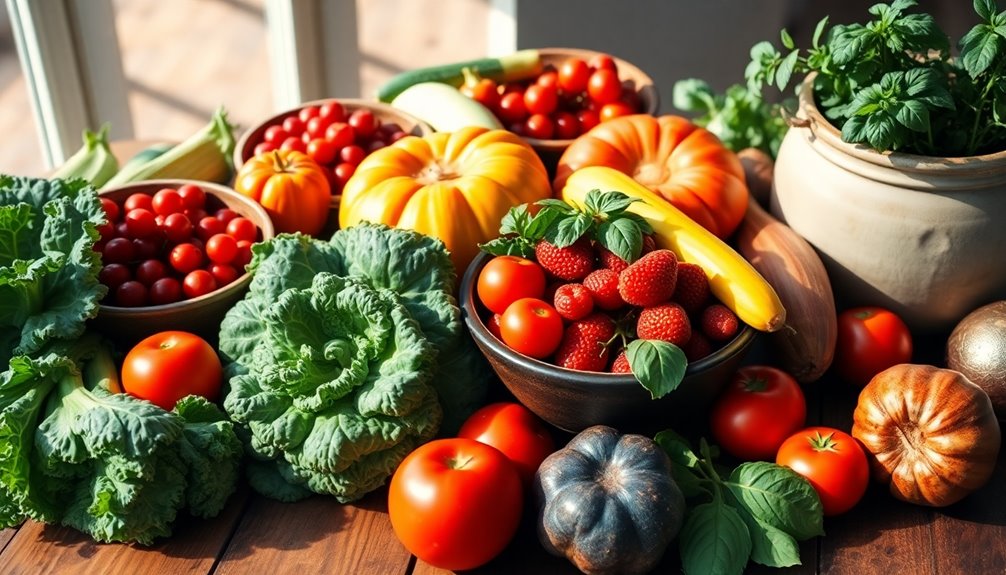
After you've enjoyed the rich flavors of global cuisines, consider how seasonal produce can elevate your meals even further. Incorporating seasonal fruits and vegetables not only enhances the taste of your dishes but also supports local farmers and reduces your carbon footprint. Shopping at your local farmer's market is one of the best ways to access fresh, seasonal produce. You'll find a vibrant selection that reflects the current harvest, making it easier to plan meals around what's available.
When you choose seasonal ingredients, you're opting for produce that's at its peak, meaning it's likely more flavorful and nutrient-rich. For example, summer brings an abundance of tomatoes, zucchini, and peppers, while fall showcases pumpkins, squash, and apples. These ingredients can inspire you to create a variety of dishes that celebrate the changing seasons. Additionally, utilizing Keto recipes from sources like the Essential Keto Cookbook can help you incorporate these seasonal finds into your meal plan seamlessly.
If you have space, consider starting your own garden harvest. Growing your own vegetables can be a rewarding experience, providing you with fresh ingredients and a deeper connection to your food. Even a small herb garden can add a burst of flavor to your meals.
Plan Theme Nights
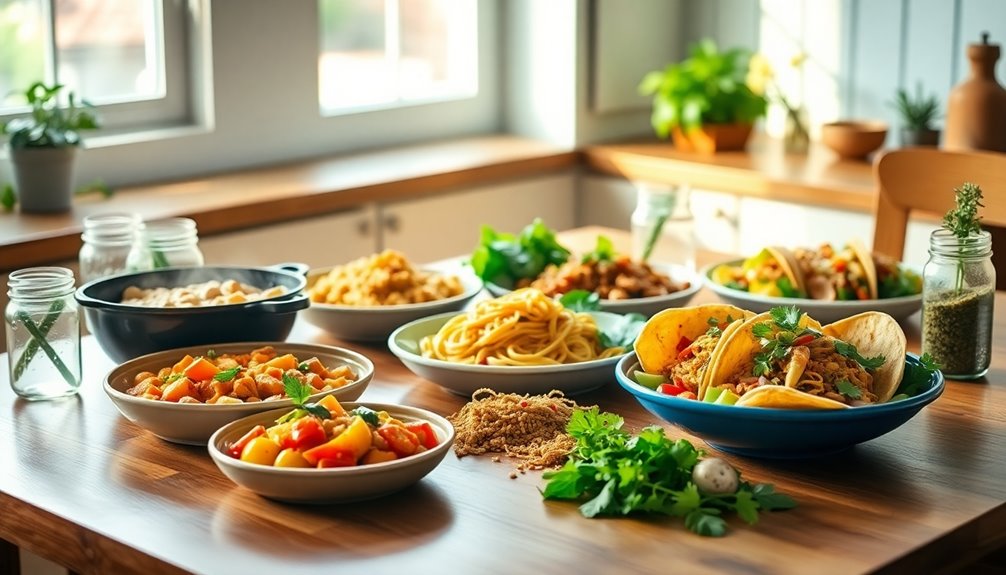
One effective way to add excitement to your meal planning is by establishing theme nights throughout the week. By designating specific nights for different cuisines or cooking styles, you create a sense of anticipation and fun for everyone involved. For instance, you might establish "Taco Tuesdays" or "Meatless Mondays," allowing you to explore diverse flavors while keeping your meals organized.
To further enhance the experience, consider hosting a family cook-off. This playful competition encourages creativity and teamwork among family members. Each person can prepare their version of a chosen dish, and you can all taste and vote on the winner. Not only does this foster a sense of belonging, but it also allows everyone to showcase their culinary skills and learn from one another.
Another great idea is to implement a recipe swap night. Invite friends or family to share their favorite recipes, whether they're cherished family dishes or new discoveries. This not only introduces you to new flavors but also strengthens bonds as you share stories behind each recipe. Additionally, consider incorporating meals that promote rapid fat loss, as they can help you achieve your health goals while keeping your menu exciting.
You could even create a communal recipe book to preserve these culinary treasures.
Experiment With Cooking Methods

Trying out different cooking methods can greatly enhance your weekly meal plan, adding texture and flavor diversity to your meals. By experimenting with various techniques, you can discover new favorites while keeping your menu exciting and fresh.
Consider incorporating grilling techniques into your routine. Grilling not only imparts a smoky flavor to meats and vegetables but also reduces the need for added fats, making it a healthier option. You can explore different marinades and seasonings to elevate your grilled dishes.
On the other hand, slow cooking methods offer a convenient way to prepare meals. When you use a slow cooker, ingredients meld together over time, resulting in rich, complex flavors. Think about preparing stews, soups, or even pulled meats that can be enjoyed throughout the week.
Baking styles can also add variety to your meal prep. From savory breads to casseroles, baking allows for a wide range of nutritious and delicious options. Experiment with different grains and vegetables to create balanced meals that satisfy everyone at the table.
Lastly, don't overlook stir frying tips. This quick cooking method preserves the color and nutrients of your ingredients while creating a satisfying texture. Try combining your favorite proteins and seasonal vegetables for a vibrant, healthful dish that's ready in minutes. Additionally, incorporating a ketogenic approach to your meal planning can help you optimize your nutritional intake while enjoying diverse flavors.
Use Meal Prep Strategies
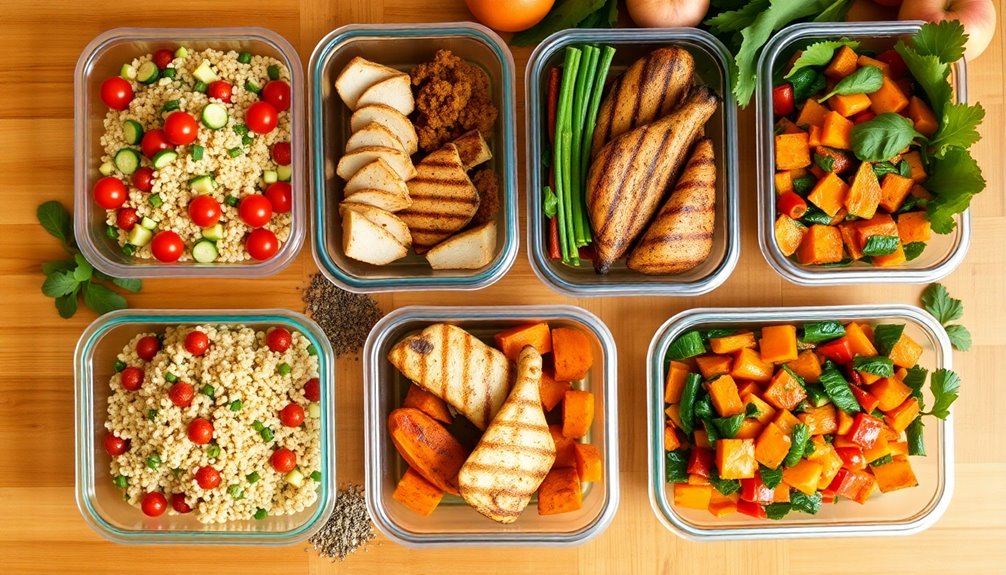
To streamline your weekly meal planning, embrace meal prep strategies that set you up for success. These strategies not only save you time but also help you stick to your budget, making them ideal for anyone looking to create delicious and varied meals each week.
Start by dedicating a few hours on the weekend for meal prep. Chop vegetables, marinate proteins, and cook grains in bulk. This way, you'll have ready-to-use ingredients throughout the week. These time-saving tips allow you to assemble meals quickly on busy days, reducing the temptation to order takeout.
Consider budget-friendly options by choosing versatile ingredients that can be used in multiple recipes. For instance, roasted vegetables can pair with grains, proteins, or be added to wraps. You'll not only save money but also minimize food waste when you plan to use ingredients across several meals.
Make use of airtight containers to store your prepped ingredients, keeping them fresh and organized. Labeling each container with the date helps you track freshness, ensuring you utilize everything before it spoils. Additionally, adopting a plant-based diet can lead to a longer lifespan, making your meal prep efforts even more rewarding.
Involve the Family

Involving the family in your meal planning can make the process more enjoyable and collaborative. When you engage everyone in the kitchen, not only do you create delicious meals, but you also strengthen family bonds and establish mealtime traditions that can last a lifetime. Here are some ways to get everyone involved:
- Host a family cooking night where each member takes turns picking a recipe.
- Create a meal calendar together, allowing everyone to contribute their favorite dishes.
- Assign tasks in the kitchen, so everyone plays a role in the cooking process.
Family cooking encourages participation and can introduce younger members to essential skills, such as meal prep and nutrition. Research shows that children who help prepare their meals are more likely to try new foods and develop healthier eating habits. Additionally, involving the family fosters a sense of belonging and teamwork, making meals more meaningful.
Moreover, incorporating a variety of foods can align with natural calorie cycles that promote a healthier lifestyle. Mealtime traditions, like themed dinners or recipe swaps, can also add excitement and variety to your week.
For example, designate a "Taco Tuesday" or "Pasta Night" where everyone gets to contribute their twist on the theme. This creates anticipation and gives everyone something to look forward to.
Keep a Recipe Journal
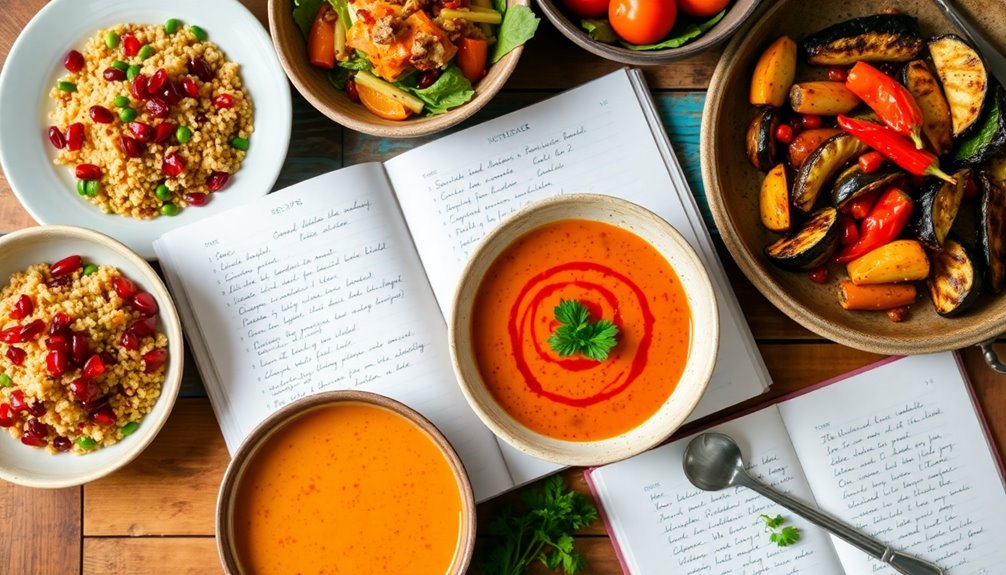
A recipe journal can become your culinary companion, helping you track your favorite meals and experiment with new flavors. By documenting your cooking experiences, you'll create a resource that not only reflects your evolving taste but also allows you to explore various flavor profiles and cooking techniques.
Start by noting down your go-to recipes, and as you try new ones, jot down tweaks or ideas for future meals. This practice encourages creativity and helps you discover what works best for your palate. Consider creating a simple table to categorize your entries:
| Recipe Name | Flavor Profiles | Cooking Techniques |
|---|---|---|
| Spicy Chickpea Stew | Spicy, Earthy | Simmering, Sautéing |
| Lemon Garlic Salmon | Zesty, Citrusy | Baking, Grilling |
| Creamy Mushroom Risotto | Savory, Umami | Stirring, Slow Cooking |
This table not only organizes your thoughts but also enables you to notice trends in your cooking habits. Perhaps you'll find that you lean toward zesty flavors or enjoy simmering dishes more often.
Additionally, sharing your journal with friends or family can foster a sense of community, as you exchange ideas and recipes. Keeping a recipe journal is more than just a record; it's a celebration of your culinary journey, inviting variety and connection into your weekly meal planning. By incorporating keto bread alternatives, you can enhance your meals while adhering to a healthier dietary approach.
Frequently Asked Questions
How Can I Find New Recipes to Try Each Week?
To find new recipes each week, explore online recipe databases and cooking blogs that cater to your tastes. You'll discover a wealth of ideas.
Consider enrolling in cooking classes to learn new techniques and cuisines, which can spark creativity in your meals.
Don't forget about cookbooks—many offer themed recipes or seasonal dishes that can keep your cooking fresh and exciting.
Experimenting with different sources can make your meals more enjoyable and diverse.
What Are Some Budget-Friendly Ways to Incorporate Variety?
Imagine your plate bursting with colors, like a painter's palette. To keep things budget-friendly, explore local farmers markets for seasonal ingredients; they're often fresher and cheaper.
Immerse yourself in ethnic cuisines—think vibrant curries or zesty tacos—to shake up your routine. Meal prep comes into play, allowing you to batch cook different dishes. This way, you not only save money but also create a sense of belonging through shared meals and flavors from around the world.
How Do I Manage Food Allergies While Exploring New Cuisines?
Managing food allergies while exploring new cuisines can be challenging, but it's definitely doable. Start by researching substitution options for your allergens; many ethnic cuisines offer allergen-free ingredients that can be delicious.
Don't hesitate to ask about allergy-friendly restaurants, as they often accommodate dietary restrictions. When trying new dishes, communicate your allergies clearly, and look for recipes that highlight safe ingredients.
This way, you can enjoy diverse flavors without compromising your health.
What Should I Do With Leftovers to Avoid Monotony?
Let's say you've got leftover roasted chicken. Instead of eating the same dish, try creative repurposing!
Shred the chicken for a flavorful taco night, mixing it with some beans and spices for a fresh twist.
You could also toss it into a salad, adding different ingredients for flavor fusion.
Meal prepping leftovers this way not only minimizes waste but also spices up your week with ingredient swaps that keep your meals exciting and varied!
How Can I Involve Kids in Meal Planning Creatively?
Involving your kids in meal planning can be a fun and creative process. Try hosting a recipe scavenger hunt, where they search for ingredients around the house.
You could also enroll them in kids cooking classes to boost their skills and confidence. Consider a DIY pizza night, letting them choose toppings and create their own combinations.
These activities not only make meal planning exciting but also foster a sense of belonging in the kitchen.
Conclusion
Incorporating variety into your weekly meal plan can transform your dining experience into a culinary adventure like no other. By exploring new ingredients, rotating protein sources, and trying global cuisines, you'll boost nutrition and excitement at the table. Don't forget to involve the family and document your favorites in a recipe journal. With these strategies, you'll not only keep meals fresh and enjoyable, but also become a kitchen maestro in no time!

